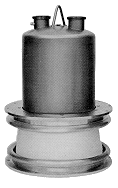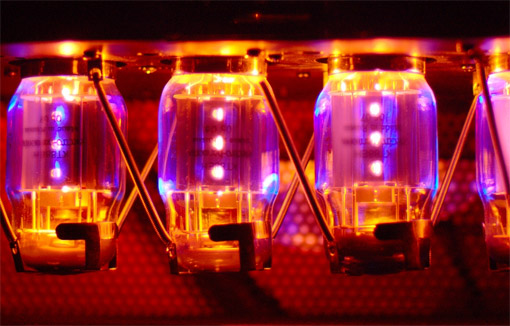Transmission
Radio frequency broadcast must often operate at high power to cover long distances. Multi-staged transistor amplifiers for radio broadcast may be sufficient up to approximately 20kW at which point vacuum tubes become more efficient. Scaling transistor amplifiers to higher powers proportionally increases the complexity of the system and solid state heat dissipation also increases. Vacuum tube technology on the other hand can be physically scaled up, without increasing the core complexity of operation. As output increases, the efficiency becomes much more attractive as a much lower proportion of the energy is lost as heat to achieve thermionic emission. The implications of this are that high powered vacuum tube based transmitters are vastly superior to transistor based solutions.
The BBC uses some very high powered transmitters to broadcast radio and television in central parts of the country, which can be found to output 100kW up to 1MW. The highest powered vacuum tube which exists today is the Eimac 8974 (a tetrode) which is able to dissipate 1.5MW; physically large and water cooled, it is used only in commercial broadcasting and military applications. Television and radio has long been transmitted using high powered vacuum tubes and will continue for some time, though fibre optic networks are becoming more common place due to their much superior bandwidth capabilities, essential for todays information age.
Military applications favour vacuum tube technology for their high power characteristics for use in radar as well as an apparent natural tolerance to electromagnetic pulses which occur during nuclear explosions as well as environmental variations due to solar emissions.
Sound Amplification
Perhaps a more curious application of vacuum tubes is its application into sound amplification. Sound, like taste, is viewed as subjective so one cannot solely use empirical quantification as evidence for the use of vacuum tubes in many modern amplifiers for musical instruments. Around the late 1940s and early 50’s originated the genre of rock and roll, with electric guitar as lead instrument, vacuum tube amplifiers were very much a part of their distinctive sound. Of course, at the time they did not have the choice of using transistor amplifiers, however, modern musicians today still very much desire the original tones created back in 50’s achievable using vacuum tube based amplifiers.
There is strong debate concerning the favourability of either type. A very significant number of people believe valve technology produces much clearer tones. Looking at specifications of high end models actually yields very similar operating characteristics. The audible difference has been shown to possibly manifest in the different harmonic responses when over driven. Valve amplifiers seem to clip much more favourably and smoothly than transistor types. Depending on which harmonic distortions are most dominant, over drive will cause varying tonal modifiers. Transistor amplifiers give off strong 3rd and 5th odd harmonic tones which have a blanket and metallic effect respectively. Valve amplifiers tend to have dominant even harmonics producing “choral or singing sounds.” These are generally accepted as much more pleasant distortion characteristics, preserving clarity further than odd harmonic dominance. Distortion is so often apparent, either on purpose or undesired, that valve based amplifiers may be though as more flexible to real life conditions than transistor based types. Only when both are kept in linear regions are they for the most part equal.
Valve amplifiers have a great shortfall it that the transformer circuits are extremely expensive. This is for the most part eliminated in transistor based designs. The consequence of this is that vacuum tube variants do not exist in the low to mid priced range for this reason alone they have been mostly replaced by solid state in mainstream consumer applications.
Unlike technology music and musical instruments are somewhat timeless so we can expect to see vacuum tubes live on in this artistic application.
Further Reading/ References:
1. http://sound.westhost.com/hfr_be.htm
2. http://www.cpii.com/docs/datasheets/81/8974.pdf
3. http://milbert.com/articles/tubes_vs_transistors